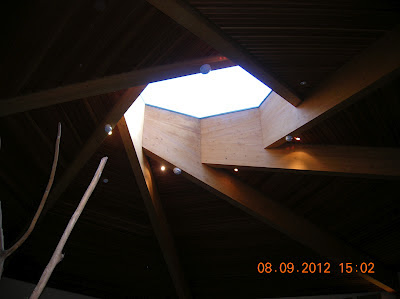Colney Woodland Burial Park
The setting of Colony Woodland Burial Park on the
outskirts of Norwich is very pleasant and many people visit this facility just to
savor its peace and tranquillity The park is available for use as a memorial
and burial ground by people of all faiths and none.
During my recent (and first) visit to the park I was
struck by one observation: All structures and memorials are made of wood. What
is the significance of this? Part of it is probably connected with the park’s policy
to maintain a sustainable burial ground; all funerary paraphernalia must be biodegradable
and this presumably allows for plots to eventually be freed up. In many ways
this is a very sensible policy in a crowded country that is increasingly aware
of the need for sustainability. However, I was left pondering the congruity between
the fabric of the park and the modern secular mindset.
I remember hearing a story of a person from a southern
culture who visited Stonehenge. Given his foreign (by Western standards)
spiritual background it was thought that he may have some insight lost to us in
the secular West as to the original purpose of Stonehenge. Consequently, he was
asked what he thought it all meant. His reply was immediate; it was a place
celebrating the ancestors. This response seems to have been largely predicated
on the fact that Stonehenge is built of …. stone. In fact stone memorials have
been raised to the dead from time immemorial: The long lasting qualities of
stone are apt symbolism for ideas about the unchangeableness and permanence of
the eternal world the dead are thought to pass into. The idea that Stonehenge's meaning is about the dead and eternity is perhaps supported by contrasting it with archaeological excavations at nearby Durrington Walls, a henge structure contemporary with
Stonehenge but instead built of wood. Archaeological evidence at Durrington Walls
suggests that it was a site of large feasts and therefore very much a place for the
living. In contrast stone built sacred precincts such as Stonehenge often leave very little
in the way of archaeological detritus, a fact that is consistent with the
idea that they were mostly frequented by a relatively small priestly elite who were society’s
link to eternity. The ancients, like us, were all too aware of the transience of
life and yet they aspired to a connection with eternity, a world symbolized by the
quasi permanence of stone.
The Woodland Burial Park’s policy is entirely
appropriate to the modern demand for sustainability and yet at the same
time its wooden fabric is very symbolic of an almost exclusive stress on the here and now. There is,
need I say, far less contemporary investment in ideas of a world beyond the
secular. Even when people do believe in the other-worldly it is likely to have
little impact in terms of related artefacts such as funerary paraphernalia;
contrast, for example, the huge industry the ancient Egyptians supported for the
purposes of the dead and their eternal life. Today, however, the emphasis for believer
and non-believer alike is on the here and now and the legacy that one’s secular
life and work leaves behind; in fact for some the memories and traces one
leaves after death is as near as it gets to eternal existence. This modern
emphasis goes together well the with wooden structures of the burial park, structures
whose material is well known to be associated with death, decay and the cycle of
rebirth; in short, all the processes that dominate secular life. For whatever
traces we leave behind they ultimately fade beyond recognition if the chaotic processes
of change and decay have the last say.
At the remembrance event I attended at the park the point
was made by the master of ceremonies, although not very convincingly, that one’s
remains partake in the ecology of the wood and thus in a sense one is still
present. But significance comes from the unique identity of pattern and configuration
rather than identity of substance. The death and decay of the body is a
startling example of what happens, if given enough time, to all the
configurations and patterns that persist after our death. If a world of change
and decay is all there is to it then thermodynamic chaos ensures that those
configurations and patterns are slowly but surely erased. There is still a need in
the hearts of many for something that will outlast all that this world can
offer; something that even outlasts stone. I don’t think that the heart of
(wo)man will ever fully come to terms with the idea that one’s ultimate destiny
is only bound up with the ecological recycling of one’s substance in a world of
change and decay.
Colney Burial Park could be indicative of the modern mind's attempt to come to terms with a purely secular existence and yet even at Colney the ambivalent signals of a doubt were expressed.
Maybe the gathering and the remembrance halls are Colney’s equivalent of
Durrington Walls and Stonehenge respectively. They both had spiralling roofs,
the spiral having connotations of eternity. The spiral in the hall where the
life of the dead is celebrated is capped with glass giving the impression of a opening
to the sky, thus tastefully and tactfully allowing the celebrant to silently let
his thoughts rest on a motif that is so easily interpreted as an open portal to
eternity, and perhaps of a hope of chance meeting with dead friends beyond circles of this world. May be this is what henge monuments were meant to convey.
Colney's symbolic portal to eternity.
See here for my Facebook album accompanying this
story:

